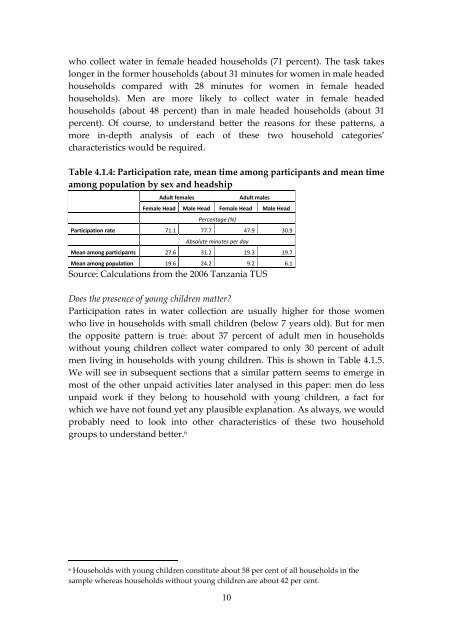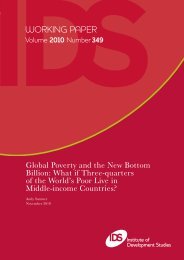Patterns of time use in Tanzania: how to make public investment in ...
Patterns of time use in Tanzania: how to make public investment in ...
Patterns of time use in Tanzania: how to make public investment in ...
Create successful ePaper yourself
Turn your PDF publications into a flip-book with our unique Google optimized e-Paper software.
who collect water <strong>in</strong> female headed ho<strong>use</strong>holds (71 percent). The task takes<br />
longer <strong>in</strong> the former ho<strong>use</strong>holds (about 31 m<strong>in</strong>utes for women <strong>in</strong> male headed<br />
ho<strong>use</strong>holds compared with 28 m<strong>in</strong>utes for women <strong>in</strong> female headed<br />
ho<strong>use</strong>holds). Men are more likely <strong>to</strong> collect water <strong>in</strong> female headed<br />
ho<strong>use</strong>holds (about 48 percent) than <strong>in</strong> male headed ho<strong>use</strong>holds (about 31<br />
percent). Of course, <strong>to</strong> understand better the reasons for these patterns, a<br />
more <strong>in</strong>-depth analysis <strong>of</strong> each <strong>of</strong> these two ho<strong>use</strong>hold categories’<br />
characteristics would be required.<br />
Table 4.1.4: Participation rate, mean <strong>time</strong> among participants and mean <strong>time</strong><br />
among population by sex and headship<br />
Adult females Adult males<br />
Female Head Male Head Female Head Male Head<br />
Percentage (%)<br />
Participation rate 71.1 77.7 47.9 30.9<br />
Absolute m<strong>in</strong>utes per day<br />
Mean among participants 27.6 31.2 19.3 19.7<br />
Mean among population 19.6 24.2 9.2 6.1<br />
Source: Calculations from the 2006 <strong>Tanzania</strong> TUS<br />
Does the presence <strong>of</strong> young children matter?<br />
Participation rates <strong>in</strong> water collection are usually higher for those women<br />
who live <strong>in</strong> ho<strong>use</strong>holds with small children (below 7 years old). But for men<br />
the opposite pattern is true: about 37 percent <strong>of</strong> adult men <strong>in</strong> ho<strong>use</strong>holds<br />
without young children collect water compared <strong>to</strong> only 30 percent <strong>of</strong> adult<br />
men liv<strong>in</strong>g <strong>in</strong> ho<strong>use</strong>holds with young children. This is s<strong>how</strong>n <strong>in</strong> Table 4.1.5.<br />
We will see <strong>in</strong> subsequent sections that a similar pattern seems <strong>to</strong> emerge <strong>in</strong><br />
most <strong>of</strong> the other unpaid activities later analysed <strong>in</strong> this paper: men do less<br />
unpaid work if they belong <strong>to</strong> ho<strong>use</strong>hold with young children, a fact for<br />
which we have not found yet any plausible explanation. As always, we would<br />
probably need <strong>to</strong> look <strong>in</strong><strong>to</strong> other characteristics <strong>of</strong> these two ho<strong>use</strong>hold<br />
groups <strong>to</strong> understand better. 6<br />
6 Ho<strong>use</strong>holds with young children constitute about 58 per cent <strong>of</strong> all ho<strong>use</strong>holds <strong>in</strong> the<br />
sample whereas ho<strong>use</strong>holds without young children are about 42 per cent.<br />
10

















